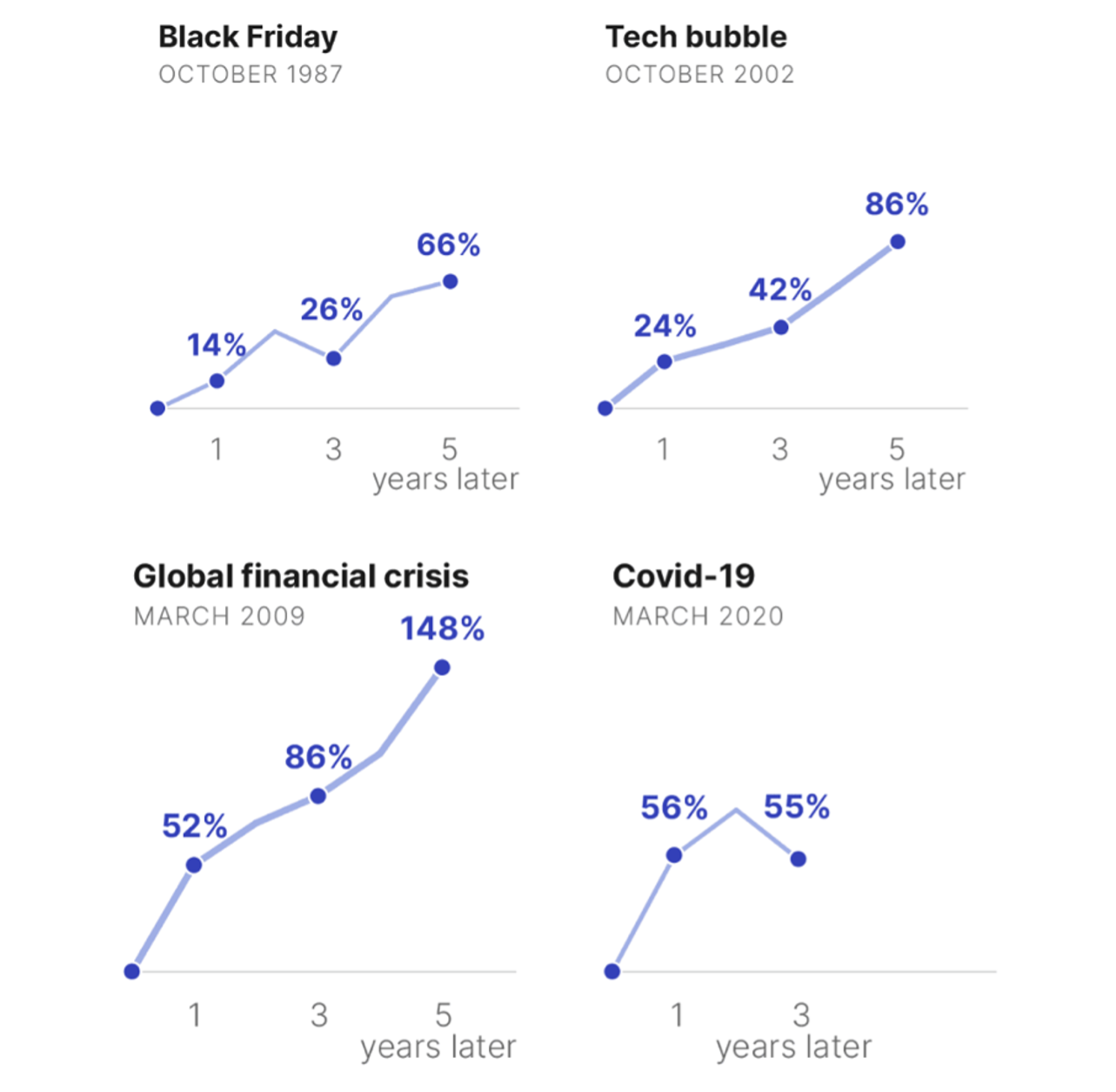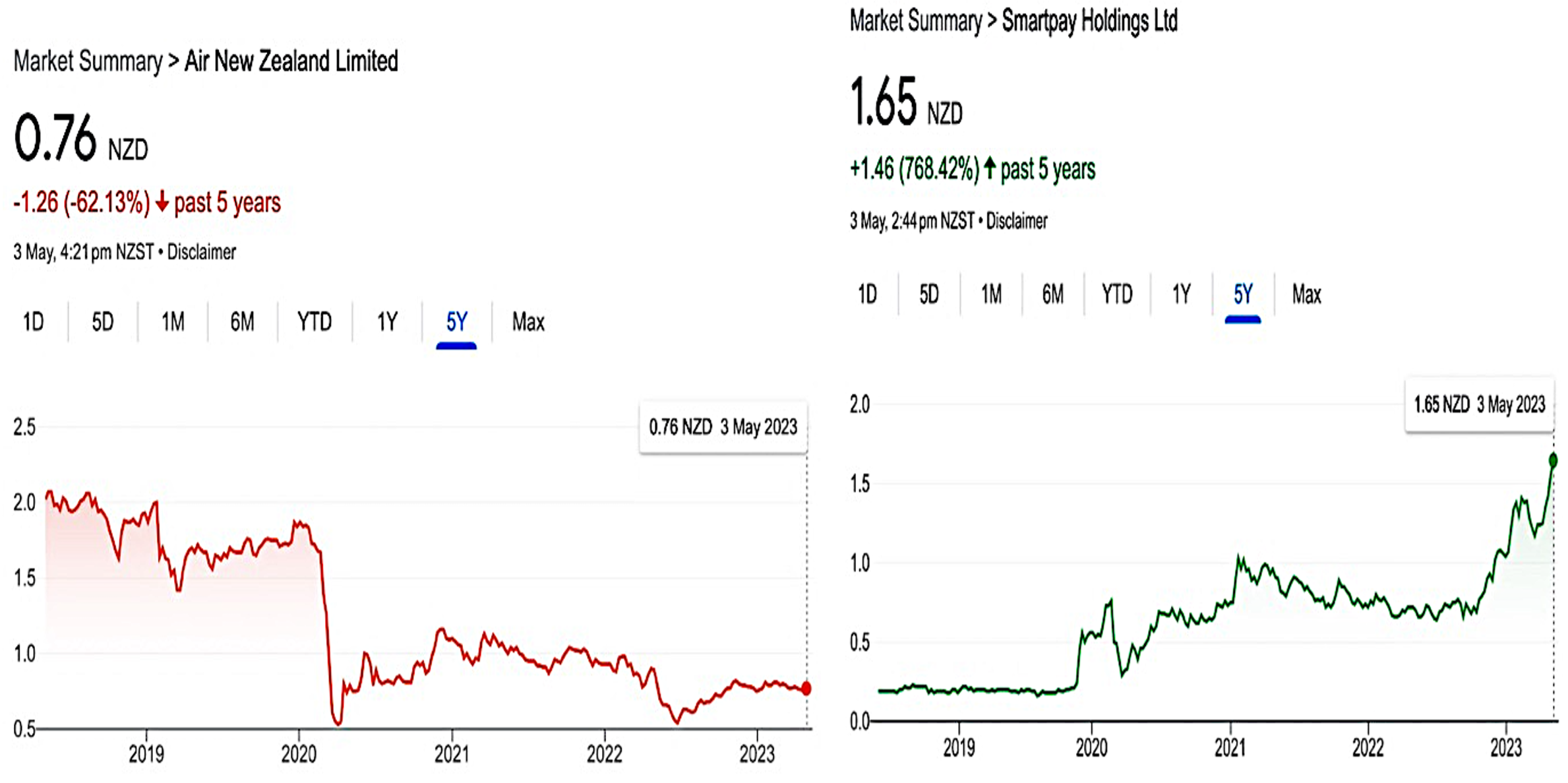Key Indicators That Lead To Investing Success
The Investment Perspective – May 2023

“Neither the investing method nor the fundamentals of the business are right or wrong because the mood of the market is favourable or unfavourable toward the “stock”. That is because when you really think about it, “stocks” (shares) are all about the financials and the trading price, the share price… the cash up value. What matters more is the economics of the business”
Peter Flannery
Key Points:
- What are the main trends to know?
- What are the markets telling us now?
- When the trading price moves, what is it telling us?
- Profit or profitability, which one is best to use?
- Auckland International Airport and Alphabet compared.
What is the market telling us?
How the market bounces back after major corrections.

The above graphs show how the American share market (the S&P 500) rebounded after sharp market corrections. [Source: Motley Fool]
As one wise and experienced investor client in Invercargill said many years ago during our meeting… “Some people just tolerate volatility; others understand it.”
My client was emphasising the point that many investors don’t like volatility and see downside volatility as a loss.
On the other hand, more advanced investors and perhaps those more experienced have seen it all before. They know that when trading prices decline, this is the time to buy (a quality business). Therefore they understand that trading price declines are not a loss but rather an opportunity to buy.
The Business

At WISEplanning, we differentiate the business from the stock.
The business could be based on innovation that creates the strong business economics (e.g. the competitive advantage).
The Stock
- Revenue
- Turnover
- Return on equity
- Price earnings growth ratio
- Etc …
These are some of the financials that we may consider when analysing a business.
They could be considered the backward looking score card. Then, there is the stock price movement, up or down.
The Underlying Business Economics
- The sustainable competitive advantage
- The ecosystem (the suite of services / products)
- Brand strength (the shortcut to the decision-making process)
- The ability of management to convert profit to free cash flow
The business, as you can see, revolves around the economics of the actual business, whereas the financials are all about the numbers.
The thing about the numbers and the financials is that they tend to be somewhat historical and, over a lengthy period of time, can provide some guidelines as to what we might be able to expect. However, last year’s profit does not drive next year’s profit. Last quarter’s profit whilst interesting, is of limited use generally.
At the risk of “getting into the weeds”, so to speak, a quarterly profit that comes in below market expectations may see the trading price decline. The market worries that this is an indication of something that is not obvious and it is not good. Actually, this can be the case at times.
Then it’s a matter of whether, even if there is something that comes to light that is negative, whether it relates to the short-term financials or has any impact on the economics of the business.
Something that comes to light that impacts on the economics of the business is certainly something to focus closely on.
Otherwise, a decline in the trading price because the market worried about a short-term financial metric might be something that we can take a look at and park to one side for future reference if need be, knowing there is no material impact on operational profitability and the economics of the actual business.
The Trading Price

The graph to the left shows the trading price of Air New Zealand over five years. The chart to the right shows the trading price of Smartpay over five years as well. [Source: Google Finance]
The trading price, in my experience, is the most popular metric used by investors to see how things are going.
In the long term, it is a useful guide. The shorter term we look though, the less reliable stock price movement becomes as a way to understand whether we have a good investment or not. That’s because the trading price, as you know, is a function of market sentiment.
When markets are happy, the trading price will rise. When markets are unhappy, then the trading price will decline. The degree of rise or decline is matched by the intensity of market sentiment – not always a good match with operational profitability.
It is prudent though, to take a look at your portfolio to see whether it’s up or down and if so, by how much. At the same time, it’s useful to know why the portfolio is up or down and how much of the movement is market-related as distinct from being driven by the fundamentals of the businesses in which you invest.
Sometimes a rising or declining share price can signal a material piece of information that should be taken seriously. More often this is not the case.
You know the old story…the price and value are not the same thing.
The trading price is driven by market sentiment, especially in the short term, whereas the intrinsic value is a function of the business’s ability to use capital.
Return on equity and return on capital are two simple measures to get an idea about how effective the business might be.
Profit vs Profitability
Profit is one of those funny words that can mean a number of different things. What other words can you think of in the English language that have more than one meaning?
Putting all that aside and keeping it simple, profit is generally a dollar amount of money that is delivered each quarter or each year from a business (we won’t get into whether it’s net profit, gross profit or some other type of profit).
Accountants and analysts can sometimes have different language around what a profitability ratio might look like. However, the first point to make here is that profit is not the same thing as profitability.
Profit and profitability are different.
For us as investors who invest in the business, we are interested in profit, but to a limited degree because profit excludes the balance sheet.
We rely more on profitability to help us identify and select a good business because it tells us more about the business than the profit number.
Yes, it’s good to know how much money a business makes over a certain period, although the shorter the timeframe, the less useful it can be.
Of much more use to us though, is the profitability of the business, which can be measured by return on equity or return on capital.
The reason we favour profitability over profit is because the return on equity or return on capital tells us how well the business uses its resources. This is not to say that the gross profit margin or the net margin is of no use to us – they are.
However, that relationship between the amount of assets being deployed and the return of those assets is a key measure of profitability that helps us to understand how one business compares with another but also how effectively the business managers can convert capital and other resources into profit. The higher the return on equity and capital, the better.
Return on equity – two examples

The chart to the left shows Auckland Airport’s return on equity. The chart on the right shows Alphabet’s future return on equity. [Source: Simply Wall St]
You can see the difference between Auckland Airport and Alphabet (Google).
Some might argue that using Auckland International Airport in this comparison is not fair because Auckland International Airport has a high level of property on the balance sheet. That said though, in some ways, it does reinforce that whole point around the total amount of capital tied up in a business and how well the business can use those resources.
Looking more closely, we can see that Auckland International Airport has a Debt-to-Equity ratio of 52%, which equates to modest and manageable debt, whereas Alphabet has no debt.
The point I’m getting to is that it is easy to show a higher return on equity when debt is involved.
In theory then, one might expect the return on equity for Auckland International Airport to be higher than Alphabet. This is not the case because Alphabet has a comparatively very efficient system for achieving a consistently higher level of return on capital. One reason is that Alphabet has less plant and equipment (and less property too).
When all is said and done, I trust you can see that the trading price, whilst interesting, is almost for entertainment in the short-term and offers little in the way of an insight into what’s going on with the business.
The reality is though, for those who play the markets, they are indeed investing in the trading price and, therefore, the trading price movement, be it up or down.
At WISEplanning, we’re investing in the business and happy to ride with the trading price up or down, increasing our holdings when the trading price is down and either sitting tight or taking off some profit when the trading price is unsustainably high.
We also know how to avoid ‘investing like a fish’ 😉
“The only mistake in life is the lesson not learned”.
Albert Einstein
